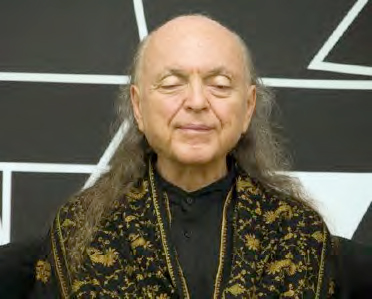2016 Geome One Screening
Los Angeles, California
October 15, 2016
Sponsor: Threshold Stairs Media

A multimedia screening of Adi Da Samraj's Geome
One: Alberti's Window, in Los Angeles, Saturday, October
15, 2016. The outdoor event beautifully coincided with the full
moon.

Sections on this page:
 Pictures
from the Screening Pictures
from the Screening
Click on images to view enlargements.
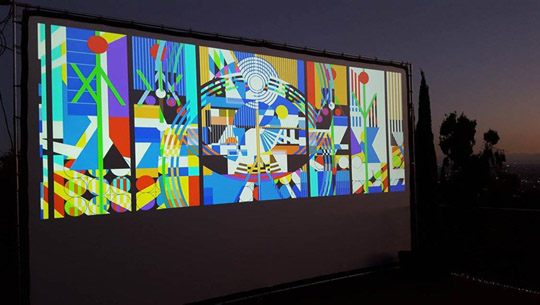
Albertiís Window I from the Geome One
Suite
(© 2016 ASA)
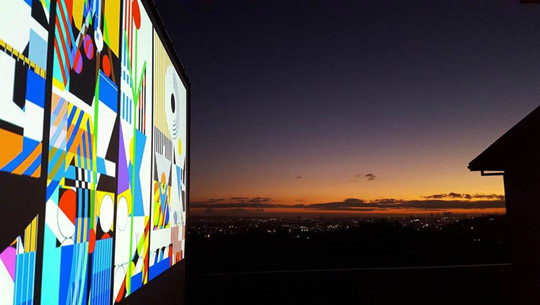
Albertiís Window I from the Geome One
Suite
(© 2016 ASA)
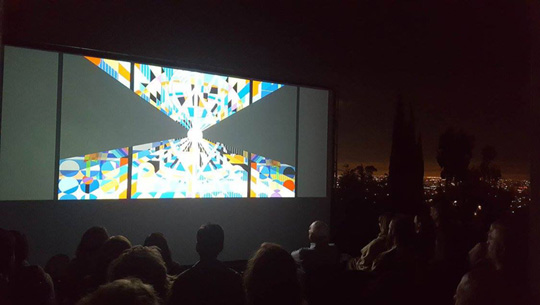
Albertiís Window I from the Geome One
Suite
(© 2016 ASA)
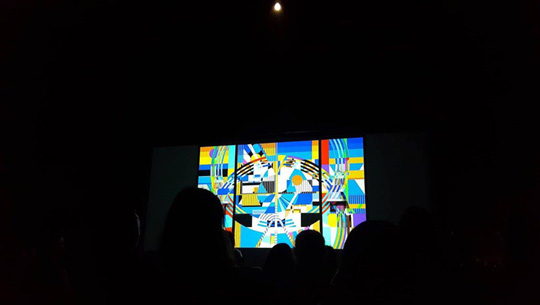
Albertiís Window I from the Geome One
Suite
(© 2016 ASA)
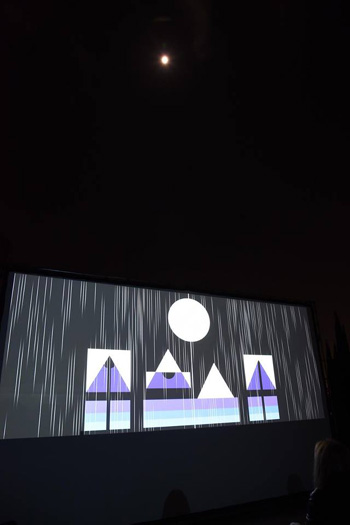
Albertiís Window I from the Geome One
Suite
(© 2016 ASA)
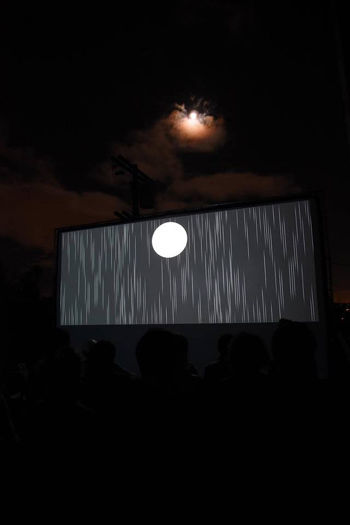
Albertiís Window I from the Geome One
Suite
(© 2016 ASA)
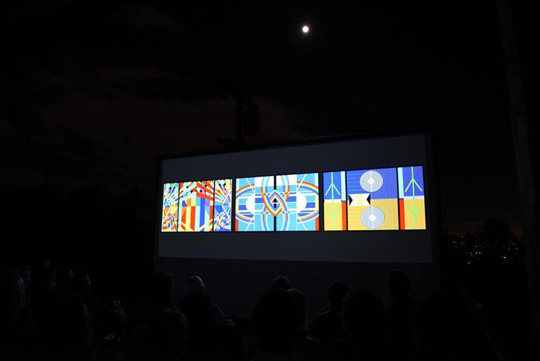
Albertiís Window I from the Geome One
Suite
(© 2016 ASA)
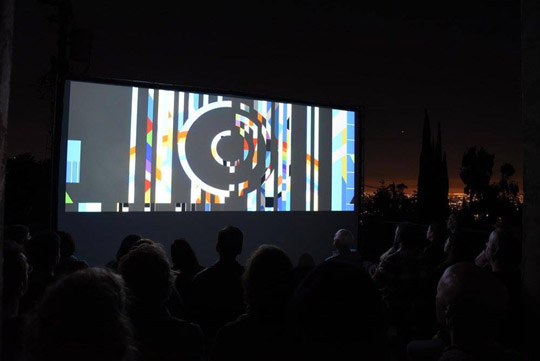
Albertiís Window I from the Geome One
Suite
(© 2016 ASA)
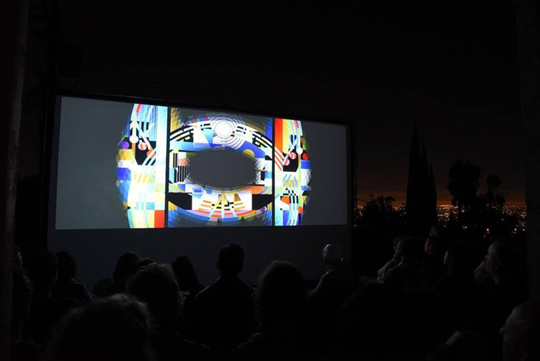
Albertiís Window I from the Geome One
Suite
(© 2016 ASA)
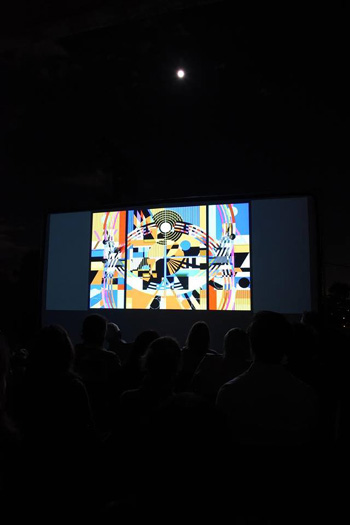
Albertiís Window I from the Geome One
Suite
(© 2016 ASA)
 Adi
Daís Albertiís Window I Adi
Daís Albertiís Window I
Excerpt from Gary J. Coates' essay, The
Rebirth of Sacred Art: Reflections on the Aperspectival Geometric
Art of Adi Da Samraj.
Adi Da’s aperspectival art is radically different from
all forms of myth-based “God-art”, as well as
all forms of perspective-based “ego-art”, and
even all forms of non-perspectival and multi-perspectival
“ego-art” of the modern and post-modern eras.
He defines the images he makes as an entirely new kind of
artistic expression. “The image-art I make and do is
‘Reality-art’--not in the conventional sense of
image-art that imitates or merely reproduces ordinary ‘reality’…but
in the sense of image-art that intrinsically egolessly
coincides with Reality Itself.”41
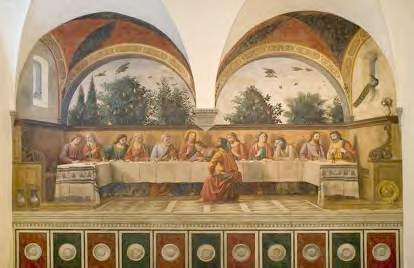
The Last Supper, a perspectival fresco by Domenico
Ghirlandaio,
Cenacolo di Ognissanti, Florence, Italy. Photo: Nick Elias
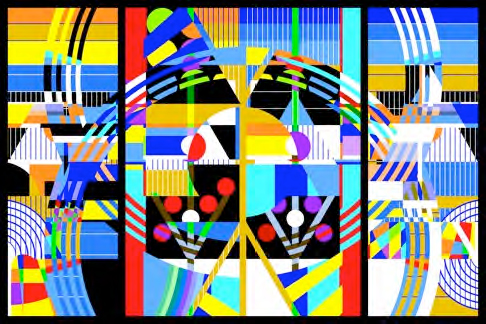
Center panel (Wednesday), Albertiís Window I, by Adi
Da Samraj
(with Vesica Piscis)

Albertiís Window I, by Adi Da Samraj (54 inches x 559
inches) invites the viewer release point of view based self-identity
and to fall into a world constituted by ďPrimary GeometryĒ
and ďPrimary ColorĒ that is free of the limiting, and ego-reinforcing
force of perspective.
By intention, then, both the design and experience of Adi
Da’s aperspectival images are radically different from
perspectival images such as Ghirlandaio’s fresco, a
fact which is powerfully evident in Alberti’s Window
I (2006-7), the largest (137 x 1,419 cm) example of Adi
Da’s recent geometric art to be included in the exhibition.
He explains: “I have given the title ‘Alberti’s
Window’ to the suite Geome One as a means of
pointing out that the image-art I make and do is, in fact,
not Alberti’s kind of space, not the traditional
space of Western art — which (first) 'objectifies' the
surface of the artwork, and (then) uses various devices to
draw the 'viewer' into the 'objectified' surface.”42
To fully understand and experience
this monumental work of art as intended, the viewer must first
un-learn his or her prior understandings of the nature and
purpose of art as well as his or her socially conditioned
habits of art viewing.43
At first glance, for example, one might be tempted to not
really “see” Alberti’s Window I,
preferring simply to breeze by it, casually noting how it
can be placed in its proper art historical category. Indeed,
it is possible to observe formal resemblances between this
image and similar works of a number of the masters of abstract
modern art. But to see this, or any other work by Adi Da Samraj,
merely as an exemplar of a type of art produced in the past
would be to miss the life-changing experience he intends his
viewer to have.44 Alberti’s
Window I, like all of the other image-art he has created
over a period of some forty years,45
is not merely a meaningless play of abstract forms and colors
on a two dimensional surface.46
Rather, it is a complex, paradoxical play between abstract
form and fundamental meaning intended to create a vehicle
for an ego-forgetting and ego-transcending aesthetic experience.47
Adi Da began the piece called
Alberti’s Window I by making photographs of
the environment in which he lives, including views looking
out of a window in his studio in Fiji. Using these images
“as a visual starting point — like a sketchbook,
and a key to unlock feeling memory”,48
he proceeded to make computer-generated images in response
to the image-content of his photographic “sketches”.49
By means of a spontaneous response to each iteration of the
developing image itself, he created over time an aperspectival
work of art radically different from the visual world of Ghirlandaio’s
fresco. Thus, as he explains, “The imagery in Alberti’s
Window does not follow the 'rules' of perspective, nor
does it presume the usual 'subject-object' orientation, as
if actually looking through a window to 'outside'. In Alberti’s
Window, the surface itself is the domain of the event
that is the image.”50
While meaning is maintained,
in part, by Adi Da’s constant reference to the original
photographs taken at the beginning of the process, the forms
and colors of Alberti’s Window I also embody
the fundamental principles of what Adi Da calls “Reality
Itself”, which, according to him, is what the world
is before it is perceived by any “point of view”
of any self-contracting ego-“I”. While it is clear
why and how linear perspective makes use of geometry to create
its spatio-temporal illusions, it is not so readily apparent
why or how Adi Da Samraj uses geometry to create order and
meaning in his art.
Noting with approval that Cezanne,
and various artists since Cezanne’s time, have created
art based on the use of primary geometries, Adi Da observes
that, when fully and deeply experienced, the structure of
human perception and the structure of the manifest world itself
are both rooted in the underlying presence and ceaseless play
of primary forces and geometries.51
He uses geometry as his primary means of artistic expression
in Alberti’s Window I, and his other aperspectival
geometric art, because he believes that this abstract formal
language speaks wordlessly and universally to the underlying
order of both self and world.52
Thus, because Alberti’s Window I is built out
of the interplay of primary geometries, it is possible to
tacitly feel, when standing in the presence of this monumental
work, that one is perceiving a meaningful field of generative
forces rather than a meaningless display of geometric forms.53
One experiences in the geometric structure of this work the
essence, rather than merely the outcome, of nature’s
processes of being and becoming.
But what of Adi Da’s use
of strong, radiant, and light-filled color in Alberti’s
Window I? Starting with his Spectra Suites in
2006, Adi Da has used a palette of “pure” colors
in order to orchestrate very specific effects: “A pure
color is a vibration…a piece of the spectrum of visible
light…Color is not arbitrary. It must be exactly right
for each image in particular. Color has emotional force.54
Colors in relation to one another generate, by that relatedness,
different modes, or tones, of emotional force.” He further
explains that, like primary geometry, color also “has
meaning in the nervous system, in the folds of the brain.
That meaning is not something that can altogether be stated
verbally, but meaning is inherent in color.”55
Thus, depending on the subject, each work of art he does requires
its own palette of colors.
Alberti’s Window I
is constructed out of a full spectrum of pure and vibrant
colors, which, like the crisp, precisely delineated geometries
characteristic of the piece, are made possible by the use
of digital technology and advanced methods of image fabrication.56
Color values range from light to dark, and include hues ranging
from cool tones at one end of the rainbow to warm ones at
the other. Each color strikes a different note, giving rise
to overtones and undertones of feeling-response and meaning-association.
One finds, for example, dark shades of cobalt blue as well
as airy tones of light-infused powder blue, in the cool end
of the spectrum, that evoke feeling-images of ocean depths
and endless skies. Robust, full-bodied hues of warm orange,
various shades of golden yellow and intense, otherworldly
reds trigger feeling-memories of spreading sunsets, the glowing
radiance of evening fires, and the rich earthy tones of soil
and rock. Woven amidst this complex field of geometrically
structured, multi-layered and interacting colors, one also
finds pure black and pure white.
Thus, even though one cannot
literally see painted images of the primal elements of earth,
air, fire and water, one can feel their presence. While Alberti’s
Window I is not representational, as in the case of such
“realistic” paintings as The Last Supper,
it does express at an archetypal level the all-pervading presence
of the primal elements and shaping forces which are always
at play in the constantly changing, self-regulating and dynamically
balanced natural world.
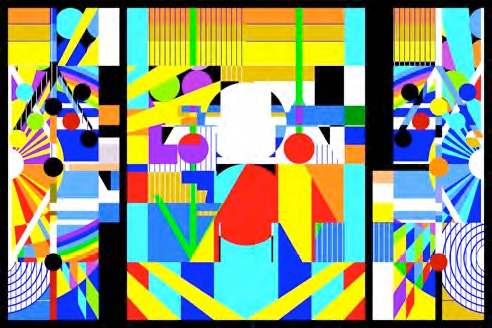
First panel, Albertiís Window I
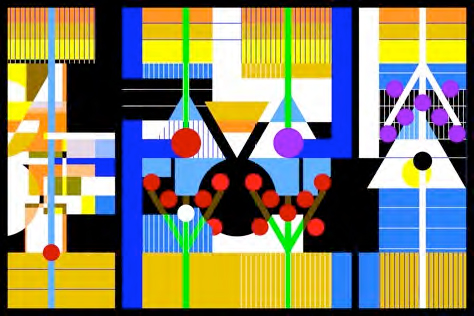
Seventh and last panel, Albertiís Window I

Albertiís Window I
But, remarkable as this accomplishment might be for any abstract
geometric work of art, Adi Da, it will be remembered, claims
much more for his images than the mere depiction of the deep
structures and archetypal experiential qualities of cosmic
nature. “My image-art is made and done to perceptually
embody — and, thus, by means of the ‘aesthetic
experience’, to communicate — the inherently egoless,
non-separate, and indivisible Self-Nature, Self-Condition,
Self-State, and Perfectly Subjective 'Space' That Is
Reality Itself.”57
Such a bold intention would suppose,
at the very least, that the perceptible visual patterns, colors
and subtle qualities of images such as Alberti’s
Window I would be homologous to what he claims is the
very nature and structure of “Reality Itself”.
While words must always fail to describe that which cannot
be said, Adi Da does indicate that “Reality Itself”,
or “That Which Is Always Already the Case” has,
“no ‘thing’ in it, no ‘other’
in it, no separate ‘self’ in it, no ideas, no
constructs in mind or perception, and, altogether, no ‘point
of view’.”58
Does Adi Da’s art measure up to this standard? Does
Alberti’s Window I communicate a sense of non-separateness
and the “irreducible paradox of unobservability and
unknowability” that he claims is the “actual (Real)
state of every one and every thing — even in the apparent
context of all things arising.”59
When first gazing upon Alberti’s
Window I, the mind and the mind’s eye race to discover
the hidden order that structures and, therefore, explains
the power and beauty of the work. One wants to get a handle
on it, figure it out, domesticate its strangeness, reduce
its complexity to something simpler, something that can be
named and known. And at first, it seems that it might be possible
to do so. Yes, there are indeed organizing structures to be
observed. First of all, one notices that the great length
of the piece is divided into seven identically sized triptychs,
each of which has a larger central panel and two smaller side
panels. The central triptych, which has two large multi-colored
circles intersecting to create a large eye-like vesica
piscis, appears at first glance to give the work a kind
of overall symmetry. Yet, a closer look reveals that there
is, in fact, no overall symmetry: the images to the left of
the central triptych are more complex and less clearly ordered
than the panels on the right of it, which are calmer, less
brightly colored, more highly ordered and more figural. Thus,
while each individual triptych might remind one of the daily
movement of the sun from morning to night, the temporal rhythm
of the overall piece is directional as one moves from left
to right, rising to a peak of balanced harmony in the center
and falling back to a state of subdued calm and greater formal
simplicity at the end. One senses in this pattern the presence
of both circular time and linear time. With this insight,
the thinking, grasping mind has something else to say about
this enormous image, something else to hold on to.
Other formal ordering devices
also can be noted and described. There are, for example, both
horizontal and vertical regulating lines, which define fields
and sub-fields where changes in geometry and color tend to
occur. Certain form motifs repeat to give an overall sense
of unity: radial patterns originating in central white circles
dance across the length of the piece; fields of vertical stripes,
containing multiple figure-ground color reversals unify the
image in the vertical dimension; triangular forms and linear
arrow-like motifs keep showing up, creating a sense of rising
and falling forces; strongly colored red, yellow, white and
blue circles of various sizes emerge as recurring figural
forms, appearing at first to be clearly separate elements,
only later to be seen as circular windows opening views into
underlying, layered fields of color, which recede or advance
according to the laws of color perspective.
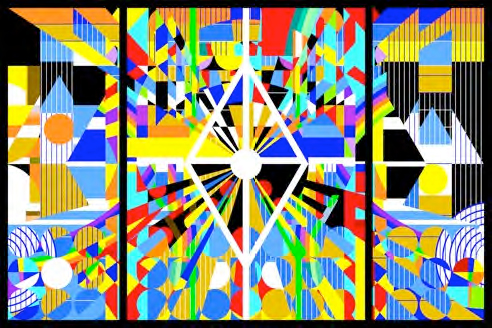
Second panel, Albertiís Window I
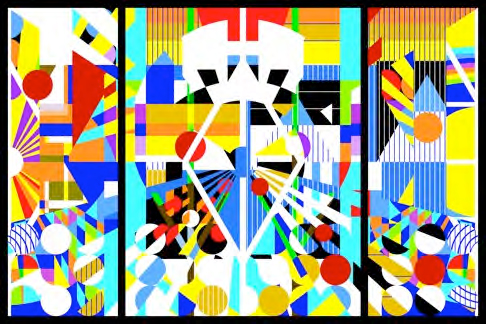
Sixth panel, Albertiís Window I

Albertiís Window I
The longer one spends with Alberti’s
Window I, however, the more it becomes evident that every
apparent ordering system is always also inevitably undermined.
Exceptions to the rule are the rule. Every instance of local
order arises only to dissolve again into a playfully creative
chaos, which is a paradoxical kind of order that can be felt
but never fully described. Eventually, one comes to the conclusion
that in Alberti’s Window I there is order without
system, in a work of art that is a living field of dynamically
balanced polarities. Symmetry and asymmetry, cool colors and
warm colors, horizontal lines and vertical lines, rising forces
and falling forces, circular forms and angular forms, advancing
colors and retreating colors, pure geometries and undefinable
shapes are woven together to create an image that is never
at rest, yet, always seems to be calm and centered. One slowly
comes to the understanding that in Alberti’s Window
I there are, indeed, no separate forms, and that a mysterious
sense of creative order and a prior, underlying unity are
all-pervading.
Finally, when the compulsive
search for order, purpose and meaning falls completely away,
and one simply becomes mindless in the face of the overwhelming
size, seductive beauty and incomprehensible complexity of
this monumental work of art, one discovers that Alberti’s
Window I cannot be defined or grasped by the mind’s
eye or the ego’s “I”. The only possible
response that is left is to surrender, simply and spontaneously
to the allure of the piece and to wander happily without any
“point of view” in the dimensionless spaces of
this primal landscape, which is a reality that is both familiar
and strange. Forms are then felt with the “eyes of the
skin”,60 colors
are sensed as temperatures and qualities of being, and order
is experienced as what Adi Da describes as a “non-necessary”
and “non-binding” appearance arising out of an
unseen reality both infinite and filled with light. In this
realm and state, there is no time and there is no space. This
experience brings a sense of freedom that is unthreatened
and unthreatening. There is only pleasure and delight that
spontaneously and naturally arises as soon as the frenzy of
seeking and the need to name and control is forgotten. This
is the experience that Adi Da describes as “aesthetic
ecstasy”, which is his true purpose in creating his
art:
|
The living body inherently wants to Realize (or Be
One With) the Matrix of life. The living body
always wants (with wanting need) to allow the Light
of Perfect Reality into the “room”.
Assisting human beings to fulfill that impulse is
what I would do by every act of image-art. My images
are created to be a means for any and every perceiving,
feeling, and fully participating viewer to “Locate”
Fundamental and Really Perfect Light — the world
As Light, conditional (or naturally perceived)
light As Absolute Light. Ultimately, when "point
of view" is transcended, there is no longer any
"room" or (any separate "location"
and separate "self") at all — but only
Love- Bliss-"Brightness", limitlessly
felt, in vast unpatterned Joy.61
|
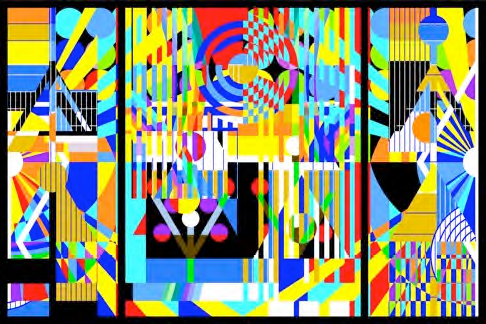
Third panel, Albertiís Window I
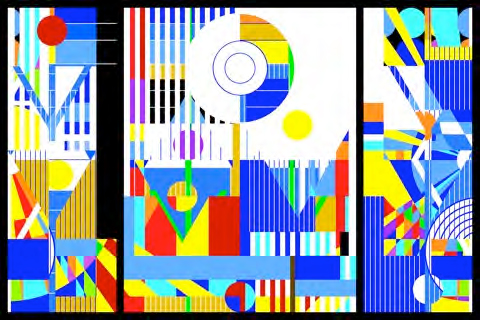
Fifth panel, Albertiís Window I

Albertiís Window I
Wassily Kandinsky wrote in 1910-11
that, “The great epoch of the Spiritual which is already
beginning…provides and will provide the soil in which
a kind of monumental work of art must come to fruition.”62
Were he alive today, Kandinsky might well consider the monumental
art of Adi Da Samraj to be the fulfillment of the spiritual-artistic
impulse that he and other revolutionary artists at the beginning
of the twentieth century sought to bring into the world through
the invention of abstract art. If properly understood and
rightly and fully experienced, the aperspectival geometric
art of Adi Da Samraj can be seen as a harbinger of a new age
of consciousness and culture.
|
|
|
ďI Am Manifesting the self-organizing force of Reality
in the context of perception and communicationóand,
therefore, of images.Ē
Adi Da Samraj
|
 Notes Notes
41
Adi Da’s “Reality-art” must be understood
as the result of a “profound philosophical and Spiritual
preparation.” He says that only after decades of the
most intensive consideration was he able to discover “the
means to go through and beyond all traditional and ego-based
modes of thinking and understanding”, making it possible
to finally make images “on an intrinsically and entirely
“point-of-view”-less basis.” As quoted in
Adi Da Samraj, Perfect
Abstraction, pg 16
42
Adi Da Samraj, Aesthetic
Ecstasy, pg 31.
43
As Adi Da says, “My image-art can be characterized as
a paradoxical space that undermines “point of view”.
That undermining (which occurs in any instant of fully felt
participation in any of the images I make and show) allows
for a tacit glimpse, or intuitive sense, of the Transcendental
Condition of Reality (even as all conditional appearances,
and, Ultimately As It Is) — always, inherently, and
totally beyond and prior to ‘point of view’.”
Adi Da Samraj, Transcendental
Realism: The Image-Art of egoless Coincidence With Reality
Itself, op. cit., pg 53.
44
“By viewing Alberti’s Window I in this art-historical
manner, I, along with even all artists who make and do images
in the geometric abstractionist mode, am eased into a convenient
position in the historical sequence of academically defined
space and time. Such a manner of viewing image-art is, ultimately,
a choice to ‘objectify’, control and be indifferent
toward the perceptually-based opportunity of profundity that
image-art is”. Adi Da Samraj, Aesthetic
Ecstasy, op. cit., , pp 14-15.
45
Adi Da argues that even though his art is abstract, meaning
is intrinsic to it: indeed, he claims that each of his works
produced over a period of more than forty years, from his
Zen-like brush paintings and multiple exposure photography
to his more recent computer-generated imagery, expresses a
fundamental tension between abstract form and meaning. For
an excellent survey of Adi Da’s entire artistic production
to date, see Mei-Ling Israel, The
World As Light: An Introduction to the Art of Adi Da Samraj,
Middletown, CA, The Dawn Horse Press, 2007. For an explanation
of the relationship between form and meaning in his work see
Adi Da Samraj, Transcendental
Realism: The Image-Art of egoless Coincidence With Reality
Itself, op. cit., pg 55.
46
He explains that he makes art that “embodies a disposition
that transcends both the ‘new’ view of image-art
as ‘surface only’ and the ‘old’ view…of
the image as a perspectivally-organized ‘window on the
world’.” See Adi Da Samraj, Aesthetic
Ecstasy, pg 14.
47
Adi Da Samraj, Transcendental
Realism: The Image-Art of egoless Coincidence With Reality
Itself, op. cit., pg 55.
48
Adi Da Samraj, Aesthetic
Ecstasy, op. cit., pg 32.
49
As is the case with all his digitally fashioned art, Adi Da
was assisted by a team of computer technicians staffing multiple
computers. He gives precise instructions about what he wants
done in terms of the form and color of the image until he
feels that the work is completely resolved. In this way of
working, nothing stands in the way of his ability to be completely
immersed in the spontaneous process of image development.
50
Adi Da Samraj, Aesthetic
Ecstasy, op. cit., pg 32.
51
Based on his own direct meditative experience Adi Da reports
that “if the deep process whereby the brain makes perception
happen is profoundly felt and (thus) understood, then it can
also be understood that the basis of the natural world’s
construction as perceptual experience is primary geometry,
or elemental shape — curved, linear, and angular.”
Not only is the perceptual process so structured, but he also
observes that “The natural world itself is (inherently)
a self-morphing and self-limiting construction (or a naturally
improvised and spontaneously self-organizing art-form), formalized
and fabricated by means of a plastic interaction between primary
forces and structures… Everything perceived is a structure
that demonstrates the interaction of these three all-patterning
forces of shape”. See Adi Da Samraj, Transcendental
Realism: The Image-Art of egoless Coincidence With Reality
Itself, pp 55-56.
52
The reason we don’t normally perceive that this is the
case, Adi Da explains, is because of the inconceivable complexity
of the interactions of primary geometries characteristic of
the natural, material world, which create an appearance of
rounded softness when seen by the natural eye. (see The
World As Light, op. cit. pg 99, and Transcendental
Realism: The Image-Art of egoless Coincidence With Reality
Itself, pg 56) Adi Da states, however, that even if
it is not possible directly to perceive the fecund and generative
presence of primary geometries in nature, “it is altogether
possible to tacitly feel that whatever is actually being perceived
in any moment is something structured in the primary geometric
manner, and that (consequently) all apparent complexity is
based on very simple primary elements.” As quoted in
Transcendental
Realism: The Image-Art of egoless Coincidence With Reality
Itself, op. cit., pg 56.
53
In an essay called “My Working Principles of Image-Art”,
in his book Transcendental
Realism: The Image-Art of egoless Coincidence With Reality
Itself, Adi Da summarizes twelve ways by which meaning
in his art is constituted through abstract geometrical form.
Several are worth quoting in order to clarify assertions made
in the main text of this essay. “5. The image-whole
is meaningful form; 6. Meaningful Form is always a play upon
the intrinsic aesthetic laws of pattern that are inherent
to the human brain and nervous system, and that underlie all
aspects of human perception, cognition , and action; 8. The
formal characteristics of the image-totality are a play between
two modes of motion (or of patterning tendency) — the
motions that are tending toward symmetry and the motions that
are tending toward asymmetry; 9. The finally realized image-whole
is a balanced resolution of the inherent conflict between
symmetry and asymmetry…; 10. Within the formal (or
meaningfully formalizing) elements of the image-play are characteristics
of polar opposition in mutual dynamic association…;
11. The finally realized image-whole is, necessarily a unified
whole, a perceptual order that is characterized by an equanimity
that demonstrates a realized balance of and between (or in
the context of) all the opposites within the meaning-field
and the image-plane; 12. The finally realized image-whole
is, necessarily, a perceptual demonstration of (both) the
root-principle of the prior unity of all conditionality and
the Transcendental Principle of the Primal Equanimity of Reality
Itself…” pp 45-46.
54
Mei-Ling Israel, The
World As Light, op. cit., pg 96.
55
Adi Da Samraj, as quoted in The
World As Light, ibid., pg 96.
56
Adi Da Samraj, ibid., pg 95.
57
Adi Da Samraj, Aesthetic
Ecstasy, pg 39.
58
Adi Da Samraj, Transcendental
Realism: The Image-Art of egoless Coincidence With Reality
Itself, op. cit., pp 56, 57.
59
Adi Da Samraj, ibid., pp 56-57.
60
For an insightful and inspiring essay on the negative effects
of the dominance of the visual sense in contemporary architecture
and culture, and the need to create an environment that speaks
to all the senses see, Juhani Pallasmaa, The
Eyes of the Skin: Architecture and the Senses, Wiley-Academy,
2005.
61
Adi Da Samraj, Transcendental
Realism: The Image-Art of egoless Coincidence With Reality
Itself, op. cit., pg 57.
62
As quoted in Maurice Tuchman (ed.), The
Spiritual in Art: Abstract Painting 1890-1985, New
York, New York: Abbeville Press, Publishers, 1986, pg 11.
|


















